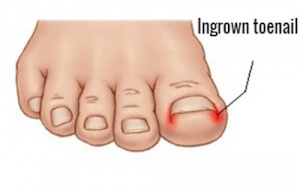How to Prevent Ingrown Toenails and Why They Occur


Reviewed and approved by the doctor Maricela Jiménez López
An ingrown toenail is when a person’s toe, (generally their big toe,) becomes curved or broken while growing. They are a very common problem and cause quite a bit of pain and discomfort.
Ingrown toenails can also be complicated to treat.
Fortunately, though, you can help prevent them with good hygiene and proper care.
How to Prevent Ingrown Toenails
If the curves or breaks get buried or don’t grow out normally, they can cause a lot of pain and discomfort while walking and even infections.
People with vascular problems, diabetes, or numbness have to be especially cautious about preventing this issue.
In extreme cases, infections can occur that lead to the necessity to amputate the affected toe.
In order to prevent ingrown toenails, it’s important that you follow these tips:
1. Maintain Good Hygiene and Make Sure Your Nails are Growing Out Correctly
Some people may ignore their toenails for long periods of time.
Or you might think that your toenails are clean when that’s actually far from the truth.
However, to prevent ingrown toenails, it’s important to keep your nails well-trimmed and clean. You should check them on a regular basis, and even daily, for abnormalities and irregularities.
When one of your nails breaks or chips, it’s very important that you clean it and make sure to keep it in the best shape possible.
2. Wear Comfortable Shoes

Fashion can be a huge contributing factor to the appearance of ingrown toenails.
Shoes that are narrow or tight in the front have unfortunately become very common. Although they may look nice and help make you look stylish, it’s crucial for you to be able to move your toes. Oxygen circulation is also really important.
You might like:
8 Things You Can Do Everyday for Healthy Feet
If you can’t avoid wearing shoes that are narrow in the front, you need to (at the very least) make sure your toes have a minimum of half a centimeter of room for free movement.
You should also make sure that the upper part of your shoe doesn’t put pressure on your nail.
This type of unnatural pressure can surely cause you to develop an ingrown toenail.
3. Avoid Close-Toed Shoes as Much as Possible
We already mentioned that one of the complications of ingrown toenails are infections. These tend to crop up for various reasons. Hygiene issues with your nails, unhygienic shoes and lack of air circulation are in the top ten.
Another thing you can do to prevent ingrown toenails is wearing sandals or open-toed shoes as much as possible.
Also, avoid wearing the same pair of shoes two days in a row if they are close-toed or if you’ve worn them for several hours.
4. See a Podiatrist Regularly
A podiatrist is a doctor who specializes in foot care and maintenance. This means that they’re a great person to see for keeping your feet healthy and free of ingrown toenails and other similar problems.
You might like:
Exfoliate Your Feet with Coconut Oil and Salt
If you are a woman and like to get pedicures, we recommend that you see a podiatrist that offers this service.
Unfortunately, people that offer pedicures don’t always have the proper knowledge about how to properly handle a person’s nails.
This could lead to them doing something wrong, thus causing ingrown nails and infections.
5. Cut Your Nails and Don’t Cause Swelling
Although we recommend that you see a podiatrist so he or she can be the one to keep your feet healthy and cut your nails properly, you can also cut them yourself. We recommend that you do this by following your nails’ natural shape.
Don’t cut too close to the skin or leave chipped or broken nails behind. If you do, those nails may very possibly become ingrown and even infected.
You should always use toenail clippers, which tend to have large blades, as opposed to fingernail clippers.
Preventing ingrown nails, along with the pain and discomfort they cause, is a simple task that only requires a little bit of your attention, but you have to maintain really good hygiene.
If you’re experiencing pain in your toes or your feet, you should see a podiatrist right away so the doctor can review your situation and correct it as quickly as possible.
All cited sources were thoroughly reviewed by our team to ensure their quality, reliability, currency, and validity. The bibliography of this article was considered reliable and of academic or scientific accuracy.
- Martínez Sabater Antonio, Pascual Ruiz Mª Francisca. Valoración del riesgo de pie diabético en el paciente anciano en una consulta de enfermería. Gerokomos [Internet]. 2009 Jun [citado 2018 Nov 18] ; 20( 2 ): 73-77. Disponible en: http://scielo.isciii.es/scielo.php?script=sci_arttext&pid=S1134-928X2009000200004&lng=es.
-
Vural, Secil et al. Risk Factors and Frequency of Ingrown Nails in Adult Diabetic PatientsThe Journal of Foot and Ankle Surgery , Volume 57 , Issue 2 , 289 – 295. Disponible en: https://www.jfas.org/article/S1067-2516(17)30582-3/fulltext
- Wesley W. Flint, Jarrett D. Cain, Nail and Skin Disorders of the Foot, Medical Clinics of North America, Volume 98, Issue 2, 2014, Pages 213-225, ISSN 0025-7125, ISBN 9780323263986, https://doi.org/10.1016/j.mcna.2013.11.002.
(http://www.sciencedirect.com/science/article/pii/S0025712513001788) - Thakur V, Vinay K, Haneke E. Onychocryptosis – decrypting the controversies. Int J Dermatol. 2020 Jun;59(6):656-669.
- Blatière V. L’ongle incarné ou onychocryptose [Ingrown nails or onychocryptosis]. Presse Med. 2014 Nov;43(11):1230-9.
This text is provided for informational purposes only and does not replace consultation with a professional. If in doubt, consult your specialist.








